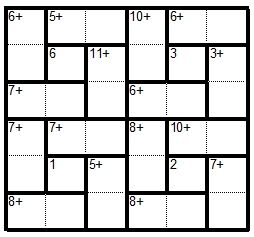
Just a simple puzzle for lovers.
| Calcudoku puzzle forum https://www.calcudoku.org/forum/ |
|
| Just a simple puzzle https://www.calcudoku.org/forum/viewtopic.php?f=16&t=666 |
Page 1 of 1 |
| Author: | nicow |
| Post subject: | Just a simple puzzle |
 Just a simple puzzle for lovers. |
|
| Author: | clm |
| Post subject: | Re: Just a simple puzzle |
nicow wrote: ... Just a simple puzzle for lovers. Thanks. Apparently easy but soon you observe more complexity. It's very curious, since initially you ignore the rules and the two pending numbers, so you must demonstrate that the solution is unique and that those numbers are necessarily 4 and 5, i.e., observing that the sum of the two pending numbers must be 9 (by using, for instance, the "addition rule" applied to three contiguous lines, and assuming that lines always contain the same numbers as in a normal Calcudoku, what gives you 21 for that sum). In these conditions, the "unknown" numbers could not be the pairs [1,8], [2,7] or [3,6] due to duplications in rows 2 and 5 and/or in columns 2 and 5 but, even considering a possible duplication, the analysis shows that [3,6], for instance, would not be possible due to cages "10+" or "11+", and similarly with the other two pairs. Other possibilities for a sum of 9, like [0,9], [-1,10], [-2,11], ... , must be analyzed as impossible; we must also demonstrate that non-integer numbers, i.e., other rational/fractional numbers (as it happens with negative numbers) are impossible. |
|
| Author: | nicow |
| Post subject: | Re: Just a simple puzzle |
Interesting. Indeed, I omitted stating the digits 1..6 had to be used. But your comment inspires me to make a script that searches for a combination of digits that yield a good puzzle. As I'm a lousy programmer, that might take some time ![Tongue [tongue]](./images/smilies/msp_tongue.gif)
|
|
| Author: | kozibrada |
| Post subject: | Re: Just a simple puzzle |
Cute… ![Wub [wub]](./images/smilies/msp_wub.gif) This type of puzzle (patterned with four quadrants), offers a “special” method how it can be solved. We mark the upper left quadrant as A, upper right as B, bottom left as C and bottom right as D. Then if we know the sum of numbers in A, we can add it to D; it same applies, of course, also to B with C (in the nicow’s puzzle, A = D = 35; B = C = 28). But not only sum, also kind and quantity of numbers are equal (again to the puzzle: there are three 1s, one 2, one 3, one 4, two 5s and one 6 in B = C). I find all points of the method very useful, especially for large puzzles (if one corner is relatively easy and the diagonal contains large cages with multiplication, for example) and for puzzles with duplicated numbers (i.e., in a 6×6 calcudoku, we have detected six 5s in A, so it can quite speed up following solving through D)… |
|
| Page 1 of 1 | All times are UTC + 1 hour [ DST ] |
| Powered by phpBB © 2000, 2002, 2005, 2007 phpBB Group http://www.phpbb.com/ |
|